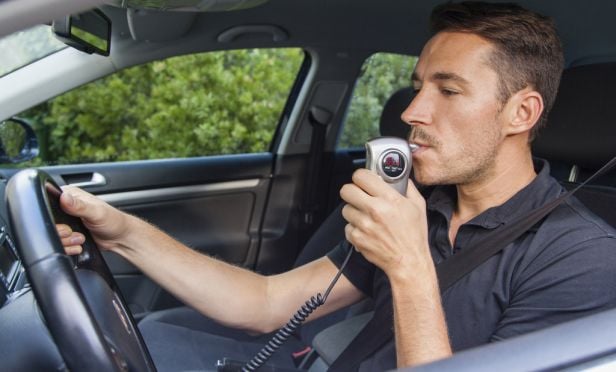
Laws requiring all impaired-driving offenders to install alcoholinterlocks reduce the number of impaired drivers in fatal crashesby 16%, a new study by the Insurance Institute for Highway Safety (IIHS) hasfound. If all states without such laws adopted them, more than 500additional lives could be saved each year, according to theIIHS.
|Related: 3 groups looking to technology to stopDUIs
|Alcohol interlocks are in-vehiclebreath-testing units that require a blood alcohol concentration(BAC) below a certain level, typically somewhere between 0.02% and0.04%, before the vehicle can be started.
|Prevalence of impaired driving
More than a quarter of U.S. crash deaths occur in crashes inwhich at least one driver has a BAC of 0.08% or higher. Theprevalence of impaired driving in fatal crashes has changed littlein the past two decades, and interlock laws are one of the fewrecent policy innovations that have made a difference, the IIHSsaid.
|Forty-five states require interlocks for at least certainimpaired-driving offenders. Twenty-eight states, the District ofColumbia, and four California counties have some type of interlockrequirement that applies to first-time offenders.
|Purpose is to reduce recidivism
The IIHS pointed out that even when they are mandated for firstoffenders, interlocks come into play only after a DUI arrest, sotheir direct purpose is to reduce recidivism. Like other types ofsanctions, however, they may act as a deterrent for those who havenot yet committed a first offense if they are well-publicized.Either way, the IIHS added, the overarching goal is to reducealcohol-impaired driving and the deaths and injuries that result,and the new study shows they have succeeded.
|“We looked at the number of alcohol-impaired passenger vehicledrivers involved in fatal crashes over time and compared them withthe number of drivers in fatal crashes that didn't involveimpairment,” said Eric Teoh, IIHS senior statistician and thepaper's lead author. “We found that state laws mandating interlocksfor all DUI offenders reduced the number of drivers in fatalcrashes with BACs of 0.08% or higher by 16% compared with nointerlock law.”
|2016: 10,497 deaths involving drivers with BAC of 0.08% orhigher
In 2016, the latest year for which fatal crash data areavailable, 10,497 people died in crashes involving drivers with aBAC of 0.08% or higher. Of those, 8,853 involved impairedpassenger-vehicle drivers. At that time, the number of states withfirst-offender laws was 25. Had all states had all-offenderinterlock requirements in place, 543 of those deaths would havebeen prevented, Teoh calculated.
|For the purposes of the analysis, Teoh and his co-authorsgrouped together two types of all-offender interlock laws: thosethat require all offenders, including first-time offenders, toinstall interlocks in order to have their license reinstated andthose that only require it to drive during a post-convictionsuspension. The analysis controlled for factors besides interlocklaws that could affect crashes.
|Related: 14 key findings from the AAA Foundation 2017traffic safety study
|Laws that required interlocks for repeat offenders only cut thenumber of drivers with BACs of 0.08% by 3% compared with nointerlock law, and that effect was not statistically significant,the study showed. Laws that required them for both repeat offendersand offenders with high BACs provided an 8% benefit.
|'Compelling body of evidence'
The executive director of the Governors Highway Safety Association, JonathanAdkins, commenting on the IIHS study, said, “This new study adds toa compelling body of evidence that [ignition interlock devices(“IIDs”)] are among the most effective drunk drivingcountermeasures available. Required IID use can deter both initialdrunk driving offenses and recidivism. While in use, IIDs alsoensure offenders can get needed support and treatment whileremaining mobile to work and care for family members. GHSAencourages all states to adopt laws mandating IID use for alloffenders.”
|Adkins added that, “[d]espite some successes in reducing drunkdriving, the problem remains both substantial and consistent. As anation, we need to be doing more to address this fundamentaltraffic safety challenge, and IID use is at the top of the list ofproven strategies.
|Steven A. Meyerowitz, Esq., is the director of FC&S Legal, theeditor-in-chief of the Insurance Coverage Law Report, and thefounder and president of Meyerowitz Communications Inc. Email himat [email protected].
|Related:
|20 car crash tips and things you shouldknow after an accident
||Want to continue reading?
Become a Free PropertyCasualty360 Digital Reader
Your access to unlimited PropertyCasualty360 content isn’t changing.
Once you are an ALM digital member, you’ll receive:
- All PropertyCasualty360.com news coverage, best practices, and in-depth analysis.
- Educational webcasts, resources from industry leaders, and informative newsletters.
- Other award-winning websites including BenefitsPRO.com and ThinkAdvisor.com.
Already have an account? Sign In
© 2024 ALM Global, LLC, All Rights Reserved. Request academic re-use from www.copyright.com. All other uses, submit a request to [email protected]. For more information visit Asset & Logo Licensing.








